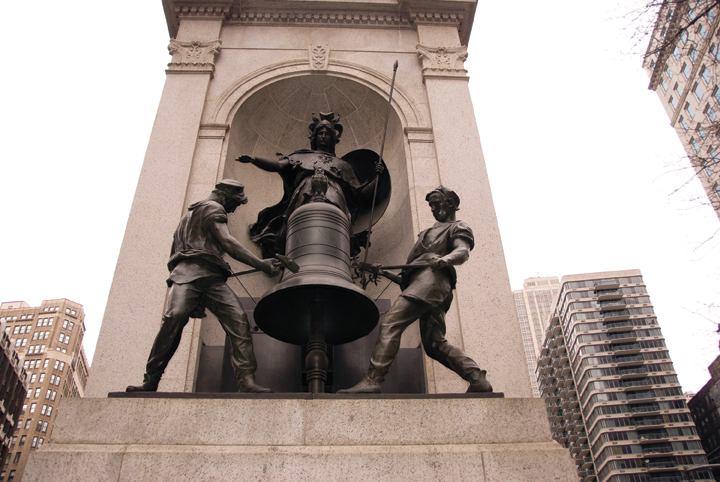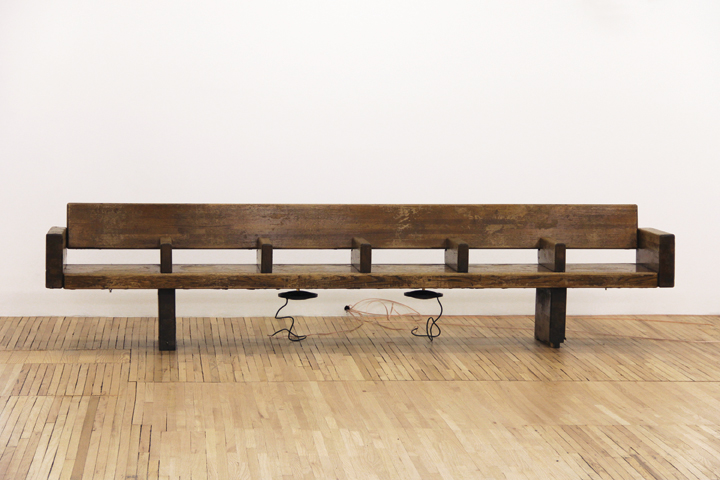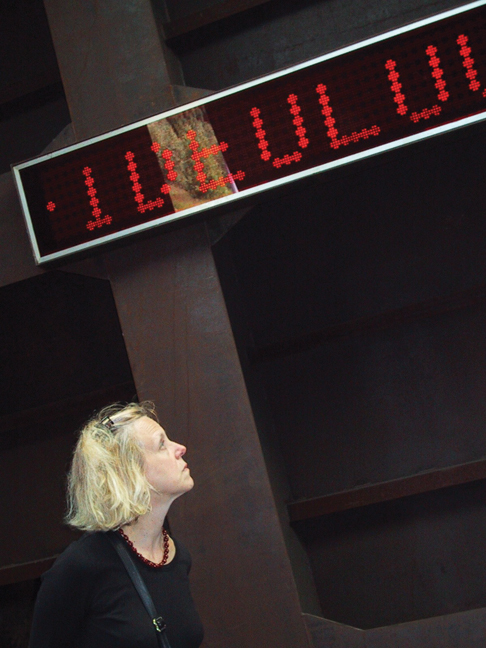« Features
The Ability to Shape Our Physical and Collective Experiences: An Interview with Barbara London about “Soundings: A Contemporary Score”
This summer, the Museum of Modern Art in New York opens “Soundings: A Contemporary Score,” a much anticipated group exhibition that promises to present the work of some of the most innovative contemporary artists working with sound today. ARTPULSE took the opportunity to interview Barbara London, MoMA’s long-standing media art curator, who has staged many memorable projects at the institution, among them the “Looking at Music” series (2008, 2009, 2011) and “Video Spaces: Eight Installations” (1995). The interview was conducted before the opening of the exhibition (August 10, 2013) and attempts to give a first impression of an undoubtedly remarkable curatorial endeavor.
By Niels Van Tomme
Niels Van Tomme - “Soundings: A Contemporary Score” approaches its topic from a variety of disciplines. Why did you choose to mount such a large-scale overview at this particular time?
Barbara London - I should begin by saying that “Soundings: A Contemporary Score” is part of MoMA’s series of contemporary exhibitions that respond quickly to current trends. As a media curator, my interest in sound has been consistent and dates back to Laurie Anderson’s Handphone Table (1978), which I organized for its premiere in our “Projects” exhibition series. Unsurprisingly, many media artists have engaged with sound as they have constructed temporal, web-based or interactive compositions. My recent “Looking at Music” shows explored the influence of music on contemporary art practices. I’ve been fascinated by the fact that many young artists today are engaged with sound for a variety of reasons. Sound is an open, relatively undefined terrain. Digital gear is extraordinarily versatile, with new, more sensitive microphones, vast storage capacities and sophisticated speakers that can be arranged to transform space, fostering physical and social experiences. The younger generation grew up downloading anything and everything. The plethora of shared sonic sources means people experience sound very differently than previous generations did. It’s inspiring.
N.V.T. - David Toop, in his book Sinister Resonance, conceptualizes sound as a haunting and a ghost, a presence whose location in space is ambiguous and its existence always fleeting. There’s indeed an unreal aspect to sound’s ephemeral nature, which is not entirely distinct from auditory hallucination. How do you conceptualize an exhibition with a medium that is never entirely ‘there,’ and how should visitors relate to sound’s intangible aspects?
B.L. - I started out with several objectives. First, sound is at the root of every work included in the show-intangibly and perceptually within the installations; sonically and visually through the sculptural objects; and conceptually upon viewing two of the artists’ drawings. Today people walk around wearing earbuds, so I took a more social approach: There are no headphones. In designing the exhibition, we paid attention to our visitors’ comfort. Installations are carpeted, and we will have soft, hassock-like seats in certain areas. We hope that our museum-goers will slow down, pay attention and listen closely, and reflect upon their experience rather than scoot by quickly and simply ‘hear’ bits.

Hong-Kai Wang, Still from 'Music While We Work,' 2011, multi-channel sound and two-channel video installation. Courtesy of the artist.
N.V.T. - What are some of the important new trends and thematic preoccupations of sound art that have informed your research for the exhibition?
B.L. - I was fascinated by ‘noise,’ by how history impacts the present, and by the fact that today field recording is such an active area.
N.V.T. - Although the exhibition highlights a younger generation of artists, in your text for the catalog you explicitly take the 1960s as a starting point for the emergence of sound as a medium for artistic expression. The history of sound art obviously extends way beyond the second half of the 20th century. Why did you choose the 1960s as a generative starting point for thinking about sound in art?
B.L. - The “Soundings…” catalog has two essays, which contextualize sound in the 20th century. My text looks back to the transformative time of the 1960s when artists readily moved between disciplines, when their focus shifted from the ‘object’ to the ‘behavior’ of art. We know that sound is perceived more directly than visual images. Some artists interested in a more direct engagement with their public have gravitated towards sound. We could say this comes out of the general shift in the 1960s of conceptualism’s informality and affinity for collectivity. Anne Hilde Nesset’s text goes further back into the earlier history.
N.V.T. - Some of the artworks in the exhibition also reference previous moments in art history. I’m thinking particularly of Marco Fusinato’s drawings based on Iannis Xenakis’ Shaar (1982) and Tristan Perich’s Microtonal Wall (2011), which references minimalism. With sound being a prime medium for experimentation and innovation, how do you contextualize such pieces that, instead, seem to be decidedly more retrospective?
B.L. - If we were to discuss contemporary art more broadly, not just sound, we would discover that nearly every art work has some connection to the past, whether that is a matter of debunking predecessors or with great respect is looking at how to propel certain titans’ ideas in a new direction. The latter is how Fusinato and Perich can be understood, as respectful innovators.

Stephen Vitiello, A Bell for Every Minute, 2010, 5-channel sound installation with aluminum sound map. Commissioned by Creative Time, Friends of the High Line and the City of New York Department of Parks and Recreation. Photo: Stephen Vitiello.
N.V.T. - One could also claim that the current, more general urge for ‘retromania’ in culture prevents innovation and propels a sense of nostalgia instead. Perhaps this is most clearly articulated in pop music, but this could also apply to current artistic practices. I’m wondering if contemporary art might articulate a fiercer position towards such broader cultural trends?
B.L. - Fusinato and Perich, who work out of long-standing study and serious research, without nostalgia, reference the past as focused builders who bridge past and future. Pop music may reflect ‘retromania,’ which will be superseded in time.
N.V.T. - For many, the categories of sound and music are inexorably linked, collapsing distinct conceptualizations of these terms. But, rather than emphasizing this link, you list music as one of the many ‘disciplinary angles’ with which sound can be associated. Can you explain how you see this relationship?
B.L. - Sound is ineffably intertwined with music. The majority of the artists with work featured in “Soundings” are practicing musicians. They may have come out of art or music school, perhaps they have played an instrument in a band or used synthesizers, but all move fluidly between mediums and disciplines. This is natural. Institutions categorize and establish definitions, which are useful handles generally for the short term, but we also rewrite or upgrade definitions regularly.

Sergei Tcherepninm, Motor-Matter Bench, 2013, wood subway bench, transducers, amplifier, HD media player, 28.5” x 20.5” x 126.5”. Image courtesy of Murray Guy, New York. Photo: Fabiana Viso.
N.V.T. - The selection of works and themes addressed throughout “Soundings: A Contemporary Score” is incredibly diverse, ranging from Jacob Kirkegaard’s field recordings of Chernobyl’s nuclear power plant site to deaf-born artist Christine Sun Kim’s pictographic scores based on notational elements from information systems. I was wondering if you could talk about some of the themes that run through the exhibition and how you will be structuring these.
B.L. - The exhibition suggests a major theme, and that has to do with the materiality of sound. Sound has the ability to shape our physical and collective experiences. We hope that the framework of “Soundings” will contribute towards a better understanding of our environment.
N.V.T. - It seems that dOCUMENTA (13) signifies a turning point for the seamless integration of sound works in large-scale international exhibitions. What prompted your decision to isolate the medium once again and to present an overview based on sound as a separate category?
B.L. - “Soundings: A Contemporary Score” is a first at MoMA. In the future sound will inevitably be more integrated. The interest here is to take a look at the broad picture. And, rather than present a clean clear narrative, the ’story’ behind the exhibition will reflect how art is made by artists who work across disciplines. We have thought about how the artists made their work and the decisions they have made. An institution has to start somewhere and goes on from there.
Niels Van Tomme is a New York-based curator, researcher and critic. He currently works at the Center for Art, Design and Visual Culture in Baltimore, where his project “Visibility Machines: Harun Farocki & Trevor Paglen” will open in the fall of 2013. Most recently, he curated the traveling exhibition “Where Do We Migrate To?” (Baltimore, New York, New Orleans, El Paso), as well as the group exhibitions “Melancholy is not enough…” (Bucharest) and “There is Nothing There” (New York).





































Leave a Reply
You must be logged in to post a comment.